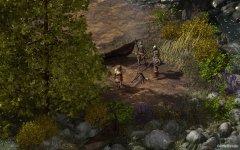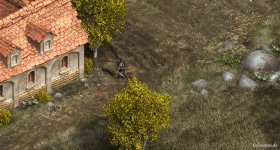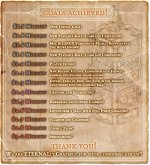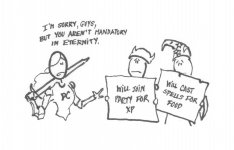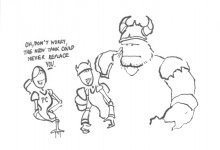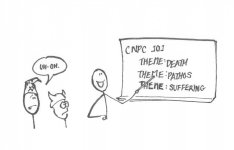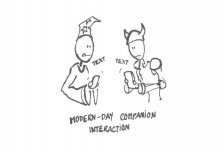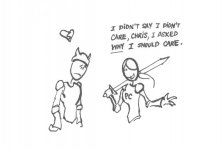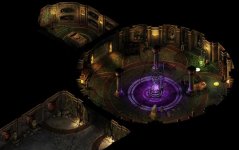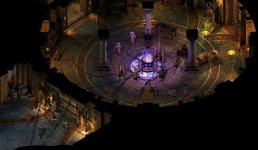LordCrash
Nerd
- Mitglied seit
- 16.04.2004
- Beiträge
- 9.599
- Reaktionspunkte
- 1.173
Project Eternity Interview (PC)
After putting on my trusty leather jacket and tempting him with some delicious iguana-on-a-stick, I was able to persuade Obsidian Entertainment’s Co-founder and Creative Director Chris Avellone to join my party. We had a chat in the rain-streaked post-apocalyptic wasteland of Birmingham regarding the Kickstarted games he was working on, namely Project Eternity, Torment: Tides of Numenera and Wasteland 2, as well as some of Obsidian’s past projects. After upping my Charisma of course.

Strategy Informer: Okay, straight out of the gate, how does it feel to be ten years old? [Note: Obsidian Entertainment turned a decade old on June 12th 2013.]
Chris Avellone: Fantastic! We’ve done a lot with the studio over the years, but the ten-year anniversary kind of creeped up on us and once we realised we’d been going for ten years we were kind of surprised, and really, really, happy. The party’s all organised, we’re sending out cards to our employees saying “guys, thanks for making this all happen,” and they’re all really stoked too. I’m really proud of that. Some start-ups, they go through some difficult changes and don’t always make that ten-year mark so to be at that point is really gratifying.
Strategy Informer: Another ten more years?
Chris Avellone: I hope so!
Strategy Informer: On to Project Eternity, how does it feel to have to do all this without publisher or PR support?
Chris Avellone: Liberating, because we get to choose what to share, you can share everything and talk about what you want, get feedback, ask the players what they’d like to see in the game. We can discuss the entire project very frankly, everything from its positive qualities to its mistakes, and even discuss design or development options with the community and get their feedback before two years down the road where it’s much harder to change something that people care about. I feel it allows us to be better entertainers.
Strategy Informer: Why is it so difficult for publishers to let things out?
Chris Avellone: I actually don’t know the philosophies of the publishers and how that situation evolved. I was never trained in marketing so there could be a whole bunch of metric studies about it. I don’t really care, my thing is that I’d much rather talk with the players about the writing side of things. I want to do post-mortems, I want to talk about the game. I feel that if players understand the process that you go through to reach the end result, they’re much more accepting of missteps along the way as well as the reasons for why you made the cool stuff that they enjoyed. It ends up better for everybody.
Strategy Informer: Is there anything about the Kickstarter or the Project Eternity experience so far that has surprised you?
Chris Avellone: Just the fact that we can share so much that I was trained never to share. Things like when we did the Wasteland 2 Vision Document [provided to backers of the game], when we put that out there I was terrified about that. Screenshots, early gameplay, terrified about them. You’re trained over time to not share those things and make them perfect before the public ever sees them otherwise there’s a huge amount of uproar, damage will be done somehow, but I haven’t got any of that. Players are excited about that, they like seeing the framework. Like I said before, it’s just liberating.
Strategy Informer: I’m very excited about Wasteland 2.
Chris Avellone: It’s looking very cool. It’s got a lot of cool situations in it, and a lot of great cults! [laughs]
Strategy Informer: As soon as I saw that gameplay video I thought “this is exactly what I want”.
Chris Avellone: It is pretty f***ing cool! They did a really nice job.
Strategy Informer: How involved were you with Wasteland 2?
Chris Avellone: I was one of the early designers involved with the first third of the project, in terms of getting the areas and the characters set up. A lot of my role was doing area design. I covered about four areas in total, although some of those areas could change in extreme ways and it felt more like designing six areas! But that was really fun since I hadn’t had chance to do area design since Knights of the Old Republic II. I felt Wasteland 2 was a good project to do that again, it felt like I was back doing Fallout 2 area design, which was absolutely wonderful.
Strategy Informer: Why do you feel like the isometric RPG kind of fell out of popularity?
Chris Avellone: I’m not sure that it did. I think that at some point people realised that the controller schemes for consoles don’t lend themselves to controlling a party of multiple people. They have to either be two people flanking you or an AI set, but you can’t have a party of six people all going on an adventure with the controller setups that they had. I think that was enough of an obstacle to knock the idea of “well, if we can’t do isometric RPGs on these particular systems then we shouldn’t do those types of RPGs”. I think things became more consolized after that.
Strategy Informer: It’s a bit sad really.
Chris Avellone: Yeah, and I think it was also much harder to sell PC-only products when it seemed like there was much more money to be made doing console ports and SKUs.
Strategy Informer: On a more positive note, consequently why do you think there has been a resurge in their popularity recently?
Chris Avellone: The interesting thing is that there has been a lot of discussion about isometric RPGs. New ones are being developed but I still think the percentage of gamers that support those titles isn’t actually a huge part of the gaming community, they’re just really passionate and they’re going to show how passionate they are about those games. For example between Wasteland 2, Project Eternity and Torment [Tides of Numenera] the backers consisted of around eighty thousand people, which to a much larger publisher those numbers are insignificant, they wouldn’t even get out of bed for numbers like that. But because the fanbase is so passionate, they’ll pay much more beyond the core price of a product, they’re willing to talk about it much more, they’re a stronger and much more vocal community, and there’s much more information being given about these games too, so I think all that creates a much higher level of attention.
Strategy Informer: And there’s always going to be an audience who will simply wait for the game to go on sale rather than back it.
Chris Avellone: Which is fine too! And I think we’ll probably see the acid test of how well this model’s doing when Wasteland 2 goes into distribution, then Eternity then Torment. We’ll get a sense of how many numbers are out there beyond just the backers, which is important to figure out but we’re just planning on the backers right now, they’re our target audience.
Strategy Informer: Have you thought up a title yet for Project Eternity?
Chris Avellone: No! I believe that is in Adam [Brennecke] and Josh [Sawyer]’s court, but currently it is just Project Eternity.
Strategy Informer: Will we ever get to an “original Xbox” type scenario where everyone knows it so well by the codename you just say “screw it, let’s just call it that”.
Chris Avellone: I don’t know about that! I don’t know if we want to decide on a title until or after pre-production and we have a good sense of the game, have written a whole bunch of dialogues, and we’ve got even more fleshed out with the themes. Sometimes as you’re doing game development the perfect title will just come to you as you’re scripting out an area or a quest, or you just start noticing a certain phrase or question that keeps popping up and you realise “hey, that’s the hook that’s being evolved here, why don’t we try to turn that into the title?”. I think that it’s important to have that larger context before we choose the title. Having the title first, it’s kind of like putting the cart before the horse!
Strategy Informer: You’re not alone of course, Double Fine only named their game [Broken Age] a month or so ago.
Chris Avellone: Yep!
Strategy Informer: Did you consider using a 3D top-down perspective like Wasteland 2 rather than the isometric style?
Chris Avellone: No, we just wanted to create more painterly dungeons, we felt that was much more the Infinity Engine experience. Also we felt there were certain freedoms we could do with the art style if we didn’t have to change the camera angle on the landscape. Of course that’s counterbalanced by the fact that Wasteland 2 is able to move more freer in the environment with the camera as a result of that, but we still wanted to create more of an Infinity Engine feel in terms of the perspective we have, wanting to do more concept art of more playful and organic environments, that was important to us.
Strategy Informer: Is Torment going for the isometric style too? That of course like Wasteland 2 is being made by InXile.
Chris Avellone: Isometric, definitely.
Strategy Informer: For me personally, even though I’m an old-school gamer I never really got into the Infinity Engine RPGs at the time for numerous reasons, such as not getting on with the interface or the frankly unforgiving level of difficulty.
Chris Avellone: Yeah, they can be pretty brutal, especially with some of the boss and mage battles that occur in Baldur’s Gate. I think one issue that still bothers me about Planescape: Torment was that although it’s a text-heavy game I found that there’s so much text at the outset it actually makes it harder to get into the game. Even though it’s giving you an example of what to expect I think the transition into the game could’ve been a little bit easier.
Strategy Informer: You’re done with Wasteland 2 now, how are you dividing your time between Eternity and Torment?
Chris Avellone: Eternity is full-time during core work hours, and then when I get home and at the weekends I deal with review and design documents for Torment, as well as talking with Kevin [Saunders] and Colin [McComb] and going back and forth with them.
Strategy Informer: Was it flattering to be a Kickstarter stretch goal for Torment?
Chris Avellone: Yes it was! I was flattered and then I was really happy, because I just wanted to work on it. Colin sent out this video once he heard that I was coming aboard and I got excited and into a cycle of enthusiasm.
Strategy Informer: Must be double flattering for George Ziets [creative lead on the respected Neverwinter Nights 2: Mask of the Betrayer expansion, who was a stretch goal for both Eternity and Torment]!
Chris Avellone: Yeah, I don’t think he minds! Also I think that George deserves much more attention than he normally gets, he’s just a quiet, reserved guy and his writing is excellent. He’s one of the best writers in this industry, when I read his stuff I don’t have any comments on it and I walk away from the dialogue that I just read thinking about it, going “oh that’s interesting”, and George’s dialogue is just awesome. When he was working on Mask of the Betrayer it was the same sort of thing, the dialogue was just cool and he had his themes down, he had a compelling hook for the player, and I was like “George gets it”.
Strategy Informer: How free-roaming is the world in Project Eternity? Is it like Baldur’s Gate with large box-areas where you go off the side?
Chris Avellone: Yeah, it’s going to be set up like that, and then you can hop to locations like you could in Icewind Dale, where dungeons and communities would open up.
Strategy Informer: How accommodating is the game going to be for those new to isometric RPGs?
Chris Avellone: I think pretty good, we’ve been really good about how to stage the opening areas of the game in our products. The goal of any opening area in an RPG is not to be punishing it’s to give the player the sense of “here’s the rules of the world, here’s how the character behaves in it” and allow the player to get a sense of how the mechanics play out. I think we did a really good job with the tutorial area in Fallout: New Vegas while still allowing the player the freedom to go through it as quickly as possible. It was much faster to get going in New Vegas than in some of the previous games we’ve done. I think we’ve got that tutorial and training stuff down, even though we don’t want to throw too much tutorial types at the player. We want to introduce areas gradually that I think we have a really good sense for, so I’m not terribly worried about it.
Strategy Informer: I can say I did prefer Fallout: New Vegas to Fallout 3, just because companions felt a lot more fleshed out and the world felt more like a real place.
Chris Avellone: Yeah I can understand that, because New Vegas ended up having a lot more people, and that set it apart from Fallout 3 where I felt like the intention was to create a very wasteland survival-like feel , and I thought they did that really well. In New Vegas because we had factions and reputation mechanics it was important to establish all these cultures in the environment, figure out how they interact with each other and create more community-based areas. Also I think in a lot of the towns in Fallout 3 there were only a few people present in each area but in New Vegas we were able to squeeze a bit more out of the locations. We’d think “hey, we want this area to feel a bit more lived in” and have more people walking around to add ambience.
Strategy Informer: It was great having the conflict between the New California Republic and Caesar’s Legion, it’s surprising how few RPGs have a full-on war going on in the background.
Chris Avellone: Yeah, seeing some of the frontlines for that conflict is pretty brutal. The designers should be really commended for that, they did a really great job.
Strategy Informer: My personal favourite though is Old World Blues [the third DLC for Fallout: New Vegas], which I came very close to giving 10/10 to – the only reason I didn’t was because I felt that Fallout fans who don’t like the weird stuff wouldn’t like it.
Chris Avellone: I think that’s fair. We had to decide at what point we drew the fourth wall and I think we came really close to it! Ultimately we just wanted the level designers to have fun, and we wanted to have fun. We had to figure out how to re-use a lot of assets and still strike a markedly different tone from the other DLC which are very serious. We wanted to break things up, get a new tone for this DLC, and go for that 1950s science feel. Then we just had a blast with it! I’d read this series called Transmetropolitan many years ago by Warren Ellis, he had this whole thing with an apartment filled with talking appliances and I was like “hey wouldn’t it be cool to have a place like that?” and so I asked one of our designers Travis Stout (who I think is working on Assassin’s Creed now) about that he was like “don’t you worry about that” and he went crazy with it.
Strategy Informer: Yeah, like the lightswitch that flirted with you!
Chris Avellone: He did a really good job on that!
Strategy Informer: Okay, final question: would you go with Kickstarter again?
Chris Avellone: Yes!
Strategy Informer: [laughs] So it was a good experience then?
Chris Avellone: Yes, absolutely. It was morale-boosting, it’s been very energetic for the whole team being able to share ideas, it ends up being more efficient in the long run, and delivers a better game.
Strategy Informer: Okay, we’ll stop it there as I am late for my train. [I really was, you know] Thanks for talking with me!
Chris Avellone: No problem!
Our chat concluded, the wayward adventurers parted company in search of nourishment, transport, and the promise of more RPG goodness to come. While there will always be big-budget 3D RPGs coming to PC and consoles (usually with a ‘3’ in title if the next year’s anything to go by) the classic party-and-story-driven RPG lives on with PCs alone. Chris Avellone will work on them, and I will play them. Will you join us? Thanks again to Chris for the chat and for all the guys at Rezzed for setting up such a swell shindig. See you in the Dyrwood.
Quelle: Project Eternity: Interview -- Strategy Informer
After putting on my trusty leather jacket and tempting him with some delicious iguana-on-a-stick, I was able to persuade Obsidian Entertainment’s Co-founder and Creative Director Chris Avellone to join my party. We had a chat in the rain-streaked post-apocalyptic wasteland of Birmingham regarding the Kickstarted games he was working on, namely Project Eternity, Torment: Tides of Numenera and Wasteland 2, as well as some of Obsidian’s past projects. After upping my Charisma of course.

Strategy Informer: Okay, straight out of the gate, how does it feel to be ten years old? [Note: Obsidian Entertainment turned a decade old on June 12th 2013.]
Chris Avellone: Fantastic! We’ve done a lot with the studio over the years, but the ten-year anniversary kind of creeped up on us and once we realised we’d been going for ten years we were kind of surprised, and really, really, happy. The party’s all organised, we’re sending out cards to our employees saying “guys, thanks for making this all happen,” and they’re all really stoked too. I’m really proud of that. Some start-ups, they go through some difficult changes and don’t always make that ten-year mark so to be at that point is really gratifying.
Strategy Informer: Another ten more years?
Chris Avellone: I hope so!
Strategy Informer: On to Project Eternity, how does it feel to have to do all this without publisher or PR support?
Chris Avellone: Liberating, because we get to choose what to share, you can share everything and talk about what you want, get feedback, ask the players what they’d like to see in the game. We can discuss the entire project very frankly, everything from its positive qualities to its mistakes, and even discuss design or development options with the community and get their feedback before two years down the road where it’s much harder to change something that people care about. I feel it allows us to be better entertainers.
Strategy Informer: Why is it so difficult for publishers to let things out?
Chris Avellone: I actually don’t know the philosophies of the publishers and how that situation evolved. I was never trained in marketing so there could be a whole bunch of metric studies about it. I don’t really care, my thing is that I’d much rather talk with the players about the writing side of things. I want to do post-mortems, I want to talk about the game. I feel that if players understand the process that you go through to reach the end result, they’re much more accepting of missteps along the way as well as the reasons for why you made the cool stuff that they enjoyed. It ends up better for everybody.
Strategy Informer: Is there anything about the Kickstarter or the Project Eternity experience so far that has surprised you?
Chris Avellone: Just the fact that we can share so much that I was trained never to share. Things like when we did the Wasteland 2 Vision Document [provided to backers of the game], when we put that out there I was terrified about that. Screenshots, early gameplay, terrified about them. You’re trained over time to not share those things and make them perfect before the public ever sees them otherwise there’s a huge amount of uproar, damage will be done somehow, but I haven’t got any of that. Players are excited about that, they like seeing the framework. Like I said before, it’s just liberating.
Strategy Informer: I’m very excited about Wasteland 2.
Chris Avellone: It’s looking very cool. It’s got a lot of cool situations in it, and a lot of great cults! [laughs]
Strategy Informer: As soon as I saw that gameplay video I thought “this is exactly what I want”.
Chris Avellone: It is pretty f***ing cool! They did a really nice job.
Strategy Informer: How involved were you with Wasteland 2?
Chris Avellone: I was one of the early designers involved with the first third of the project, in terms of getting the areas and the characters set up. A lot of my role was doing area design. I covered about four areas in total, although some of those areas could change in extreme ways and it felt more like designing six areas! But that was really fun since I hadn’t had chance to do area design since Knights of the Old Republic II. I felt Wasteland 2 was a good project to do that again, it felt like I was back doing Fallout 2 area design, which was absolutely wonderful.
Strategy Informer: Why do you feel like the isometric RPG kind of fell out of popularity?
Chris Avellone: I’m not sure that it did. I think that at some point people realised that the controller schemes for consoles don’t lend themselves to controlling a party of multiple people. They have to either be two people flanking you or an AI set, but you can’t have a party of six people all going on an adventure with the controller setups that they had. I think that was enough of an obstacle to knock the idea of “well, if we can’t do isometric RPGs on these particular systems then we shouldn’t do those types of RPGs”. I think things became more consolized after that.
Strategy Informer: It’s a bit sad really.
Chris Avellone: Yeah, and I think it was also much harder to sell PC-only products when it seemed like there was much more money to be made doing console ports and SKUs.
Strategy Informer: On a more positive note, consequently why do you think there has been a resurge in their popularity recently?
Chris Avellone: The interesting thing is that there has been a lot of discussion about isometric RPGs. New ones are being developed but I still think the percentage of gamers that support those titles isn’t actually a huge part of the gaming community, they’re just really passionate and they’re going to show how passionate they are about those games. For example between Wasteland 2, Project Eternity and Torment [Tides of Numenera] the backers consisted of around eighty thousand people, which to a much larger publisher those numbers are insignificant, they wouldn’t even get out of bed for numbers like that. But because the fanbase is so passionate, they’ll pay much more beyond the core price of a product, they’re willing to talk about it much more, they’re a stronger and much more vocal community, and there’s much more information being given about these games too, so I think all that creates a much higher level of attention.
Strategy Informer: And there’s always going to be an audience who will simply wait for the game to go on sale rather than back it.
Chris Avellone: Which is fine too! And I think we’ll probably see the acid test of how well this model’s doing when Wasteland 2 goes into distribution, then Eternity then Torment. We’ll get a sense of how many numbers are out there beyond just the backers, which is important to figure out but we’re just planning on the backers right now, they’re our target audience.
Strategy Informer: Have you thought up a title yet for Project Eternity?
Chris Avellone: No! I believe that is in Adam [Brennecke] and Josh [Sawyer]’s court, but currently it is just Project Eternity.
Strategy Informer: Will we ever get to an “original Xbox” type scenario where everyone knows it so well by the codename you just say “screw it, let’s just call it that”.
Chris Avellone: I don’t know about that! I don’t know if we want to decide on a title until or after pre-production and we have a good sense of the game, have written a whole bunch of dialogues, and we’ve got even more fleshed out with the themes. Sometimes as you’re doing game development the perfect title will just come to you as you’re scripting out an area or a quest, or you just start noticing a certain phrase or question that keeps popping up and you realise “hey, that’s the hook that’s being evolved here, why don’t we try to turn that into the title?”. I think that it’s important to have that larger context before we choose the title. Having the title first, it’s kind of like putting the cart before the horse!
Strategy Informer: You’re not alone of course, Double Fine only named their game [Broken Age] a month or so ago.
Chris Avellone: Yep!
Strategy Informer: Did you consider using a 3D top-down perspective like Wasteland 2 rather than the isometric style?
Chris Avellone: No, we just wanted to create more painterly dungeons, we felt that was much more the Infinity Engine experience. Also we felt there were certain freedoms we could do with the art style if we didn’t have to change the camera angle on the landscape. Of course that’s counterbalanced by the fact that Wasteland 2 is able to move more freer in the environment with the camera as a result of that, but we still wanted to create more of an Infinity Engine feel in terms of the perspective we have, wanting to do more concept art of more playful and organic environments, that was important to us.
Strategy Informer: Is Torment going for the isometric style too? That of course like Wasteland 2 is being made by InXile.
Chris Avellone: Isometric, definitely.
Strategy Informer: For me personally, even though I’m an old-school gamer I never really got into the Infinity Engine RPGs at the time for numerous reasons, such as not getting on with the interface or the frankly unforgiving level of difficulty.
Chris Avellone: Yeah, they can be pretty brutal, especially with some of the boss and mage battles that occur in Baldur’s Gate. I think one issue that still bothers me about Planescape: Torment was that although it’s a text-heavy game I found that there’s so much text at the outset it actually makes it harder to get into the game. Even though it’s giving you an example of what to expect I think the transition into the game could’ve been a little bit easier.
Strategy Informer: You’re done with Wasteland 2 now, how are you dividing your time between Eternity and Torment?
Chris Avellone: Eternity is full-time during core work hours, and then when I get home and at the weekends I deal with review and design documents for Torment, as well as talking with Kevin [Saunders] and Colin [McComb] and going back and forth with them.
Strategy Informer: Was it flattering to be a Kickstarter stretch goal for Torment?
Chris Avellone: Yes it was! I was flattered and then I was really happy, because I just wanted to work on it. Colin sent out this video once he heard that I was coming aboard and I got excited and into a cycle of enthusiasm.
Strategy Informer: Must be double flattering for George Ziets [creative lead on the respected Neverwinter Nights 2: Mask of the Betrayer expansion, who was a stretch goal for both Eternity and Torment]!
Chris Avellone: Yeah, I don’t think he minds! Also I think that George deserves much more attention than he normally gets, he’s just a quiet, reserved guy and his writing is excellent. He’s one of the best writers in this industry, when I read his stuff I don’t have any comments on it and I walk away from the dialogue that I just read thinking about it, going “oh that’s interesting”, and George’s dialogue is just awesome. When he was working on Mask of the Betrayer it was the same sort of thing, the dialogue was just cool and he had his themes down, he had a compelling hook for the player, and I was like “George gets it”.
Strategy Informer: How free-roaming is the world in Project Eternity? Is it like Baldur’s Gate with large box-areas where you go off the side?
Chris Avellone: Yeah, it’s going to be set up like that, and then you can hop to locations like you could in Icewind Dale, where dungeons and communities would open up.
Strategy Informer: How accommodating is the game going to be for those new to isometric RPGs?
Chris Avellone: I think pretty good, we’ve been really good about how to stage the opening areas of the game in our products. The goal of any opening area in an RPG is not to be punishing it’s to give the player the sense of “here’s the rules of the world, here’s how the character behaves in it” and allow the player to get a sense of how the mechanics play out. I think we did a really good job with the tutorial area in Fallout: New Vegas while still allowing the player the freedom to go through it as quickly as possible. It was much faster to get going in New Vegas than in some of the previous games we’ve done. I think we’ve got that tutorial and training stuff down, even though we don’t want to throw too much tutorial types at the player. We want to introduce areas gradually that I think we have a really good sense for, so I’m not terribly worried about it.
Strategy Informer: I can say I did prefer Fallout: New Vegas to Fallout 3, just because companions felt a lot more fleshed out and the world felt more like a real place.
Chris Avellone: Yeah I can understand that, because New Vegas ended up having a lot more people, and that set it apart from Fallout 3 where I felt like the intention was to create a very wasteland survival-like feel , and I thought they did that really well. In New Vegas because we had factions and reputation mechanics it was important to establish all these cultures in the environment, figure out how they interact with each other and create more community-based areas. Also I think in a lot of the towns in Fallout 3 there were only a few people present in each area but in New Vegas we were able to squeeze a bit more out of the locations. We’d think “hey, we want this area to feel a bit more lived in” and have more people walking around to add ambience.
Strategy Informer: It was great having the conflict between the New California Republic and Caesar’s Legion, it’s surprising how few RPGs have a full-on war going on in the background.
Chris Avellone: Yeah, seeing some of the frontlines for that conflict is pretty brutal. The designers should be really commended for that, they did a really great job.
Strategy Informer: My personal favourite though is Old World Blues [the third DLC for Fallout: New Vegas], which I came very close to giving 10/10 to – the only reason I didn’t was because I felt that Fallout fans who don’t like the weird stuff wouldn’t like it.
Chris Avellone: I think that’s fair. We had to decide at what point we drew the fourth wall and I think we came really close to it! Ultimately we just wanted the level designers to have fun, and we wanted to have fun. We had to figure out how to re-use a lot of assets and still strike a markedly different tone from the other DLC which are very serious. We wanted to break things up, get a new tone for this DLC, and go for that 1950s science feel. Then we just had a blast with it! I’d read this series called Transmetropolitan many years ago by Warren Ellis, he had this whole thing with an apartment filled with talking appliances and I was like “hey wouldn’t it be cool to have a place like that?” and so I asked one of our designers Travis Stout (who I think is working on Assassin’s Creed now) about that he was like “don’t you worry about that” and he went crazy with it.
Strategy Informer: Yeah, like the lightswitch that flirted with you!
Chris Avellone: He did a really good job on that!
Strategy Informer: Okay, final question: would you go with Kickstarter again?
Chris Avellone: Yes!
Strategy Informer: [laughs] So it was a good experience then?
Chris Avellone: Yes, absolutely. It was morale-boosting, it’s been very energetic for the whole team being able to share ideas, it ends up being more efficient in the long run, and delivers a better game.
Strategy Informer: Okay, we’ll stop it there as I am late for my train. [I really was, you know] Thanks for talking with me!
Chris Avellone: No problem!
Our chat concluded, the wayward adventurers parted company in search of nourishment, transport, and the promise of more RPG goodness to come. While there will always be big-budget 3D RPGs coming to PC and consoles (usually with a ‘3’ in title if the next year’s anything to go by) the classic party-and-story-driven RPG lives on with PCs alone. Chris Avellone will work on them, and I will play them. Will you join us? Thanks again to Chris for the chat and for all the guys at Rezzed for setting up such a swell shindig. See you in the Dyrwood.
Quelle: Project Eternity: Interview -- Strategy Informer
Zuletzt bearbeitet:


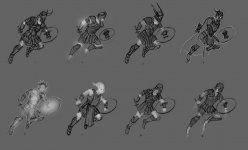
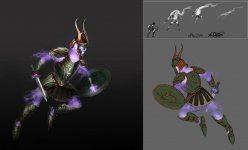



.gif)
